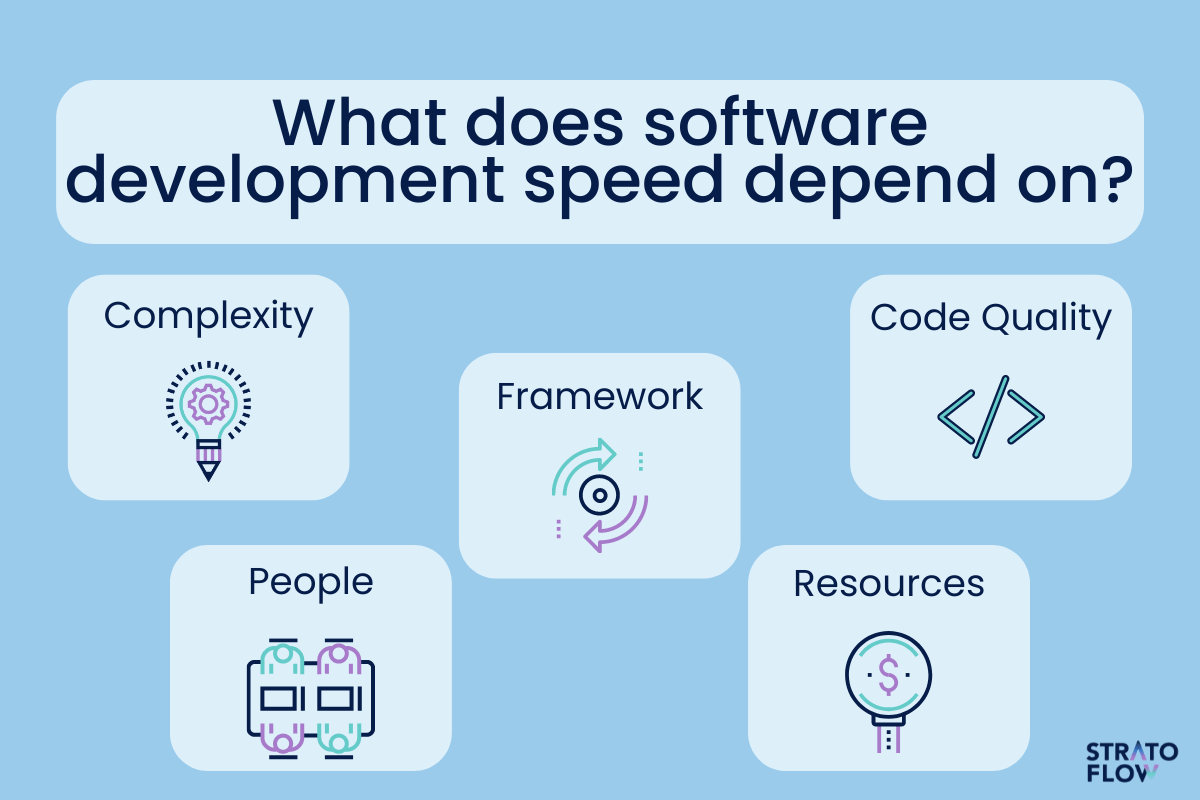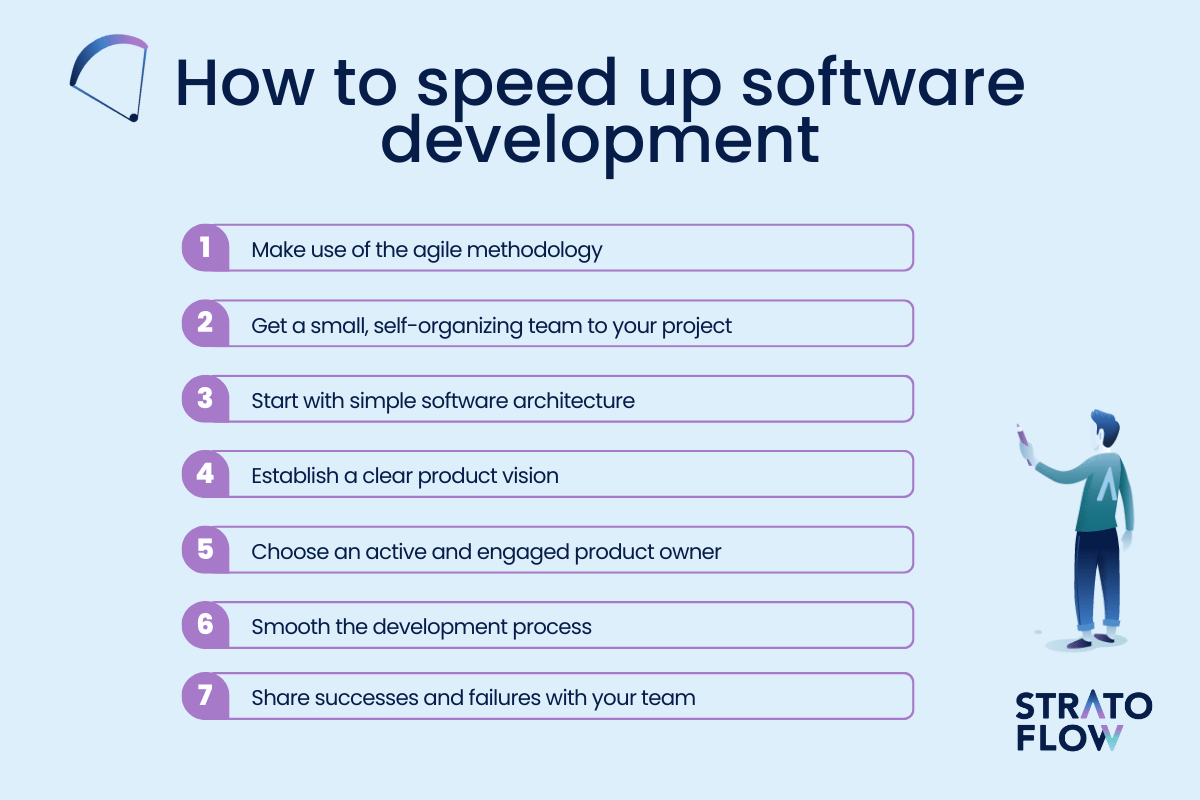
7 Practical Tips on How to Speed Up the Software Development Process
Software development in itself is a complex process consisting of various little parts, methodologies, and factors that have to work in tandem in order to yield positive results. When one part of this complex machine fails, all remaining elements will also suffer in the process, negatively impacting the overall speed of the entire development process.
In this article, we are going to cover the most common factors hurting the speed of software development, as well as some practical tips from our extensive experience on how to improve it.
Contents
- What does software development speed depend on?
- 1. Complexity
- 2. People
- 3. Framework
- 4. Resources
- 5. Code Quality
- Top 7 tips on how to speed up software development
- 1. Make use of the agile methodology
- 2. Get a small, self-organizing team to your project
- 3. Start with simple software architecture
- 4. Establish a clear product vision
- 5. Choose an active and engaged product owner
- 6. Smooth the development process
- 7. Share successes and failures with your team
What does software development speed depend on?
So, how to speed up software development?
Let’s start by examining the possible root causes of the problems with development speed.
1. Complexity
This point is pretty much self-explanatory, but let’s look at it the following way.
Back in the pioneering days of gaming, when consoles like the Atari 2600 were all the rage, it was popular for a single developer to make a complete game in a couple of months.
These days a big triple-A title, like Red Dead Redemption 2, can take a team of hundreds of top-class developers years to develop.
This is all because the complexity and scope of such projects have grown by orders of magnitude in the past decades.
There are several various obstacles that a development team will encounter during its work. The more complex the project, the more hurdles coders will have to overcome.
3 types of project complexities that will affect the overall development speed:
- Project requirements complexity
When building a business relationship with a custom software development company, a clear understanding of the required functionalities of the project should be established. If not done in advance, it will lead to an eventual time loss on calls and meetings that could have been avoided down the line. - Technical challenges
Some projects require the usage of complex software architecture, third-party integrations, or developing innovative solutions from the ground up. All of this can lead to an increased complexity, which in turn affects development speed. Such things have to be settled at the initial planning phase in order to set up realistic project timeframes. - Structural complexity
When there are many workflows, resources, and stakeholders involved in a product development, it is becoming increasingly difficult to coordinate, manage, and control such operations.

2. People
People are a company’s most valuable asset.
However, their work is not linear, and they do not maintain the same level of efficiency the entire time. This is completely expected and natural. There are periods during the year, such as holiday season or Christmas, when it is expected to see a much slower software development speed as many people take their days off.
Another issue that affects speed of the software development process is the size of the team.
Even though the performance of a whole team depends on the contribution of each member, increasing the team size won’t always lead to better results. The success of each project relies mostly on the efficiency of internal communication.
For example, at Stratoflow, one of our priorities is for developers to enjoy working with each other. Through a very careful recruitment process, we have built teams where communication is seamless. Not only does job satisfaction grow on a daily basis, but also customer satisfaction.
In most cases, a development team of more than seven people may experience problems with finding common ground on current tasks. The solution is to support the team by an experienced project manager.
There is also one more issue – skills and experience of developers (Check our experts tips on how to find software developers).
It’s common to think that with highly-skilled team members, you can expect a faster development speed. However, it does not mean that you should completely disregard less-experienced coders. The key for product owners is to provide every team member with tasks suited to their level as well as their area of expertise.
[Read also: Nearshore software development]

[Read also: The Most Common Problems in Software Development]
3. Framework
In the IT field, a framework is a structure that allows programmers to build working code, resulting in an overall faster software development process.
It is a sort of foundation that you can build applications upon. This way, there is no need for starting each project entirely from scratch.
Each framework is closely associated with a specific programming language and is suited to different types of tasks.
There are different types of frameworks depending on their designated purpose:
- Front-end frameworks – like Angular, React JS, or Vue JS,
- Back-end frameworks – like Ruby on Rails, Spring Boot, or Django.
- Mobile frameworks – like Java, React Native or Flutter.
To find out exactly how is Java used in software development, click the link to our in-depth guide.
Choosing a framework that your team is unfamiliar with can have a big, negative influence on the overall development speed of the entire project.
[Read also: The Most Efficient and Environment Friendly Programming Languages]
4. Resources
A relatively small change in project scope or requirements may cause a substantial rise in complexity. And that requires large changes in the software architecture and project design.
What software houses should avoid?
An uncontrolled expansion of project scope, with more features and functionalities than was originally anticipated from the chosen architecture.
The development speed can be affected quite badly when requirements change too frequently and not all changes are discussed thoroughly with the team.

5. Code Quality
The development speed and code quality usually lie on the opposite sides of the scale.
If you put too much emphasis on the speed of the project, code quality will inevitably suffer.
If a development team has tight deadlines and a huge amount of tasks to complete in a single sprint, they may rush the process. Skipping tests, taking shortcuts, and neglecting the overall code quality and clarity is the most possible scenario.
Even though at first, the project progress might move on quicker, bugs will pop up sooner or later. And that requires fixing and rewriting parts of the entire code. What’s more, such pressure is a straight path to making your developers burnt out and lose the passion and trust in your project.
The key takeaway is that – especially when dealing with big projects – proper planning, code reviews, and testing should play a vital part in the enterprise software development process.
[Read also: Guide to Java Profilers: Which Performance Monitoring Tool Is the Best?]
Top 7 tips on how to speed up software development
At Stratoflow we have over 9 years of experience in software development for many international clients. Over this period we’ve learned a lot about what works and what doesn’t when it comes to project management.
Below, we’ve listed 7 of the most important tips and practices on how to improve the speed of the development process. Enjoy!
 `
`
1. Make use of the agile methodology
Recently, one of the most successful and popular ways of improving project management in software development companies is introducing agile methodology. It is currently being used in organizations all across the world to accelerate workflows and keep up with the fast-paced future of work.
Agile is an iterative approach to project management and application development that helps teams deliver value to their customers faster and with fewer obstacles along the way.
At its core, there are self-organized and cross-functional teams that pay close attention to changing circumstances and user needs and adapt their projects accordingly. Development teams that work in scrum and agile methodology improve the quality of their code by working in short sprints with smaller deliverables.
Recent studies show that software development projects using Agile methodologies are 28% more successful, and currently almost 71% of software houses use Agile methodology with varying frequencies.
[Read also: How to Build Low Latency Java Applications]
2. Get a small, self-organizing team to your project
Since project complexity can substantially increase the delivery time of a development project, the number of committed developers also influences the time of completion.
It is worth noting, though, that there isn’t a one-to-one correlation between these two things.
To put it differently, increasing the number of developers in a team does not automatically increase the software development speed.
Five senior developers can be more efficient than eight entry-level ones. Despite this, without proper management, large teams will encounter much more problems with internal communication as well as with the delegation of tasks.
From our experience, the approach that is the most effective is to break down a large development project into smaller, manageable chunks. You can then delegate these small components of the project to small, self-organizing teams.
Agile development combined with many small components and team structures built around them leads to small, but highly productive teams.
Combine that with solid and systematic tests and integration methodology, and you have a recipe for success.
All of that will enable developers to accomplish their goals much faster, as well as bring your customers desirable outcomes within agreed-upon timeframes.
[Read also: Power of Cloud Computing Scalability: Empowering Businesses to Scale with Ease]

3. Start with simple software architecture
Over the last couple of decades, technology has evolved rapidly. Many tech stacks have become obsolete, while some architectures have gained much popularity among the development community. We can differentiate 5 most common software architectures that are currently in use:
1. Monolithic architecture
Monolithic systems are based on a single-tiered application where the individual logical components (e.g. user interface, data processing, integrations, etc.) are combined into a single program.
The main advantage of this architecture is fast development time and potentially lower latency with limited serialization/deserialization events. The most challenging disadvantage is the growth of a single codebase over time that may become difficult to maintain, test and deploy.
[Read also: How to Choose a Software Development Company – CHECKLIST]
2. Layered (n-tier) architecture
One of the most common software architectures that organizes system components into horizontal layers is n-tier architecture.
Its biggest upside is the fact that it is pretty easy to get your head around and work with, with closed layers of code offering a high level of control that help testing and maintenance. On the other hand, though, it confines itself to mostly monolithic applications and even small modifications can require complete redeployment of an app. It can also cause performance issues when data requests are going through too many layers that are performing some functions.

3. Event-driven architecture
Event-driven architecture is gaining traction in recent years and is regarded as one of the leading trends in software development. An event-driven architecture uses events to trigger and communicate between spread-out services.
This type of software architecture has three key components: event producers, event routers, and event consumers. The event-driven architecture allows for a better interactive experience for the end-user with modern interactivity demands by delegating away many of the most demanding functionalities.
4. Microservices architecture
Main disadvantage of the monolithic approach is due to its high degree of integration. When one part of the code fails it usually brings down the whole application with it.
Microservices, on the other hand, use APIs and communication protocols to interact with each other, but they don’t rely on each other otherwise. Thanks to that, they allow for more separation so that if one (or several) parts die, the application can partially operate. This architecture also does well when implemented in large organizations with multiple development teams.
Then every team can write, maintain, and deploy each microservice independently, improving workflows as well as lowering the overall responsibility of an individual developer.
[Read also: What is Low-Code/No-Code?]
5. Microkernel architecture
Last but not least we’ve got microkernel architecture which, some experts say, falls between microservices and monolithic architectures. It requires only a limited amount of software to implement an OS.
In this architecture, the microkernel is the only software allowed to execute at the privileged level. The other functionalities of the OS, even the important ones, are removed from the kernel mode and run solely in the user mode. It improves both modularity as well as the security of the entire system.
There’s no simple and ultimate answer to the question of the best software architecture, since different solutions will work best in different business scenarios. It is worth keeping in mind, though, that in reality, most problems are just variations of previously solved ones.
When scoping for the best architectural solutions, you can search through similar applications and solutions, look for what they’ve used in the past and see how it served them in the long run.
There is also a possibility of integrating elements of different software architectures to achieve the best results.
However, to get this right, you will need an experienced and trustworthy team of knowledgeable software developers.
Taking that into account, it is better to keep in mind these 4 points when choosing, adjusting, and expanding your software architecture:
- Simplicity,
- Maintainability,
- Interconnectivity,
- Processing Performance.
[Read also: Legacy Software Systems: How to Live with Aging Software Architecture?]

4. Establish a clear product vision
Before you dive deeper into all the details of the project, a clear vision of the finished product has to be established.
Without a clear product vision, the software development team might have trouble seeing the big picture. There is a risk of frequent course changes as well as the presence of various disagreements on what to do next.
When developers do not see what value their work will provide, it can feel disorienting and demotivating.
Creating a cohesive product vision also helps when preparing a future road map and product development strategy, and to decide which tasks should be prioritized and which not. It will tell you what actions will bring the project to completion.
A clear and concise roadmap of the entire custom software development project should be built and discussed with the whole team before a software development process begins. Having a well-defined product vision and a firm plan for the coming months will enable you to determine the key performance indicators and metrics to track progress.
Another great way to accelerate software development is to build a minimum viable product (MVP) before going all in into end-to-end software product development.
MVP in software development is a pretty bare-bone version of a product with enough features to attract early-adopters to test the idea in the real market in the early stages of the software development cycle.
In doing so it might turn out that a lot of the initial feature ideas may prove unnecessary. It will also enable you to polish the entire product vision and roadmap to ensure future market viability.

5. Choose an active and engaged product owner
Another key aspect of boosting the pace of software development are project managers and product owners who play an active role in software development teams.
A product owner is a role in a team working in a scrum and agile methodology that is responsible for the entire project’s outcome. The product owner seeks to maximize a product’s value by managing and optimizing the product backlog.
A product owner is also responsible for one of the key parts of the entire software development process, i.e. outlining a strong vision of a finished product’s function and operation.
It will allow other team members to better define specific features and break them into specific backlog tasks.
So in a nutshell, a product owner in a modern, agile software development team is responsible for:
- defining and developing product features;
- creating and taking care of product backlog tasks;
- connecting clients and stakeholders with team members, as well as working out satisfying terms of cooperation.
From our experience, the best outcomes for developers as well as clients take place when a product owner is a technical person who is also an active member of the development team itself.
Since the entire software development process is full of various complexities and nuances, a technical person who is familiar with each team member’s strengths and weaknesses will be able to accurately give realistic timeframes for the project, as well as delegate tasks from backlog to fellow team members.

6. Smooth the development process (short iterations = short feedback loop)
They say that iteration length should correlate with the release cycle.
At Stratoflow we tend to follow a different approach and believe that shorter iterations provide the development team with more much-needed feedback.
A short feedback loop enabled by the short iterations software development approach gives the team more opportunities to reflect and improve their work practices.
That’s another of the core parts of agile methodology: putting emphasis on delivering working software to users as quickly as possible using recurring short development cycles.
We believe that a development cycle (sprint) should typically encompass two weeks in which the team focuses on building a specified set of functionalities.
This ensures flexibility and adaptability when necessary changes have to be made with every development sprint.

7. Share successes and failures with your team
Almost all experienced software teams will have their own best practices developed throughout the years.
Each senior developer has dealt with some unique obstacles in the past during their career and maybe in the process developed some innovative method that could prove to be very helpful for the future projects.
Sharing successes and failures with a development team can not only improve relations between individual team members but also act as a great learning experience for less skilled developers.
Some good practices can even be later developed into full-fledged development standards as long as there is consensus among expert developers, they are documented, agreed upon by all teams in the company, and most importantly – introduced to all levels of the organization.
Follow up reading:
Java Best Practices That Every Java Developer Should Know in 2023
Best Practices for Writing Software Documentation
How to speed up software development process – summary
Without a doubt, software production time is an incredibly consuming process. Bigger development projects can take an entire organization made up of numerous experienced programmers months or even years to develop.
It is thus crucial to implement steps that will increase overall development speed in order to stay within agreed-upon project timeframes. If you are interested in low-code development that simplifies and speeds up development process and play an important role in digital transformation, we recommend you follow-up reading:
Related Posts
- Best AI for Coding: Top 10 AI Tools for Software Developers in 2025
- Future of Digital Transformation and Trends in 2024: Expert View
- How to Build an Inventory Management System: Key Steps and Tips
- How to Build a Document Management System: Alternative Approach
- Online Shopping Recommendations – Introducing Them to Your Business
We are Stratoflow, a custom software development company. We firmly believe that software craftsmanship, collaboration and effective communication is key in delivering complex software projects. This allows us to build advanced high-performance Java applications capable of processing vast amounts of data in a short time. We also provide our clients with an option to outsource and hire Java developers to extend their teams with experienced professionals. As a result, the solutions designed for our customers contribute to their business development. We specialize in travel software, ecommerce software, and fintech software development. In addition, we are taking low-code to a new level with our Open-Source Low-Code Platform.